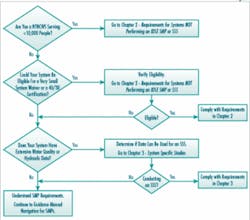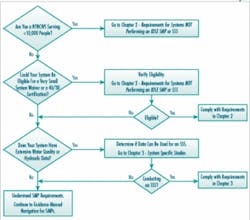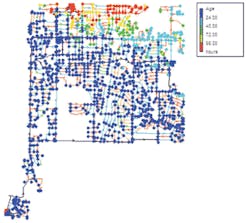Practical Advice on Initial Distribution System Evaluations
The Initial Distribution System Evaluation (IDSE) is a major component of the upcoming Stage 2 Disinfectants and Disinfection Byproducts Rule. This rule was proposed by EPA on August 18, 2003, and it is anticipated that the final rule will be published in late 2005. While the basic MCLs for TTHM and HAA remain at 80 and 60 µg/l, respectively, there are significant changes that will affect what a public water system must do to remain compliant.
Major provisions of the new rule include:
• Compliance with MCLs is based on Locational Running Annual Averages (LRAA)
• Significant Excursions (short-term DBP peaks)
• Uniform Regulation of Consecutive Systems
• Initial Distribution System Evaluations
IDSE requirements of the Stage 2 DBPR apply to all community water systems that add a primary or residual disinfectant other than UV and consecutive CWSs that deliver water that has been treated with a disinfectant other than UV. Also affected are non-transient, non-community water systems serving at least 10,000 people.
The purpose of the IDSE is to identify areas in the distribution system with representative high DBP concentrations. EPA defines the IDSE as follows:
“IDSEs are studies that, when used in conjunction with existing compliance monitoring, help systems identify and select future compliance monitoring sites representing high TTHM and HAA5 levels in the distribution system.”
EPA’s Stage 2 DBPR
Implementation Guidance
Multiple compliance avenues exist for the IDSE, so the first decision a water system must make is which option(s) to select. Systems serving less than 500 people may receive a waiver from their primacy agency. Systems that have DBP data that is consistently low (below 40 µg TTHM/l and 30 µg HAA5/l) may qualify for the 40/30 Certification. The 40/30 Certification requires a report to the primacy agency, but a full IDSE is not required.
Multiple compliance avenues exist for the IDSE, so the first decision a water system must make is which option(s) to select. Systems serving less than 500 people may receive a waiver from their primacy agency. Systems that have DBP data that is consistently low (below 40 µg TTHM/l and 30 µg HAA5/l) may qualify for the 40/30 Certification. The 40/30 Certification requires a report to the primacy agency, but a full IDSE is not required.
Decision Tree from EPA Guidance Manual
Systems required to perform an IDSE have two basic options. The default option is the Standard Monitoring Program (SMP), which entails one year of distribution system monitoring for disinfection by-products to determine locations where TTHM and HAA5 are highest. The number and location of monitoring points will be determined by system source and size. Generally, sampling will be required near entry points, at historically high TTHM and HAA5 sites, and at locations defined by the system’s average residence time. The required number and frequency of samples ranges from two samples every 180 days to 48 samples every 60 days.
Alternately, a system may opt for a System-Specific Study (SSS). Systems that already have a significant amount of DBP data and/or a computer-based hydraulic model of the distribution system may find this to be an attractive option.
Systems should begin planning for the IDSE and talking with their primacy agencies. For systems serving at least 10,000 people (and some consecutive systems), IDSE Reports will be due two years after promulgation of the final rule (“Early Schedule”). This means that a one-year sampling program should be initiated within nine months of promulgation of the final rule. Other systems will be on EPA’s “Late Schedule,” which requires a completed IDSE to be submitted four years from promulgation of the final rule.
EPA’s website has everything you could ever want to know about the Stage 2 Disinfectants and Disinfection Byproducts Rule. In addition to the full text of the proposed rule as published in the Federal Register, the following helpful publications are available for download:
• Fact Sheet on the Stage 2 Disinfectants and Disinfection Byproducts Rule (2 pages)
• Stage 2 Disinfectants and Disinfection Byproducts Rule Implementation Guidance (134 pages)
• Initial Distribution System Evaluation Guidance Manual (341 pages)
About the Author
Tom O’Connor, PE, ([email protected]) is an owner of H2O’C Engineering in Columbia, MO, where he specializes in the design, evaluation, modeling, and optimization of water and wastewater systems.


